Recreation centers keep popping up all over the country. These centers are typically large and expensive to build. Creative financing is often required to get these projects off the ground and to provide the programming that stakeholders want and need.
Take, for example, the 135,000-sf Foglia Foundation Health and Recreation Center at Harper College in Palatine, Ill., which reopened last September after a $41 million renovation of that 40-year-old building, led by designer CannonDesign and construction manager Mortenson.
The community college collaborated on this project with Northwest Community Healthcare, which agreed to pay for the fitout of a new clinic that originally was going to be 5,000 sf but expanded to 10,000 sf, says Steve Paterson, Harper College’s campus architect. The college leases this space, known as the NCH Outpatient Care Center, to the hospital, and its services are available to students, employees, and the community.
The Building Team added 10,000 sf to the rec center to make way for new fitness and exercise rooms, six classrooms, and team training and competition areas, including a new dedicated wrestling room and sports medicine facilities with a hydrotherapy bath. The rec center is also headquarters for the Harper Golden Hawks athletic department and teams.
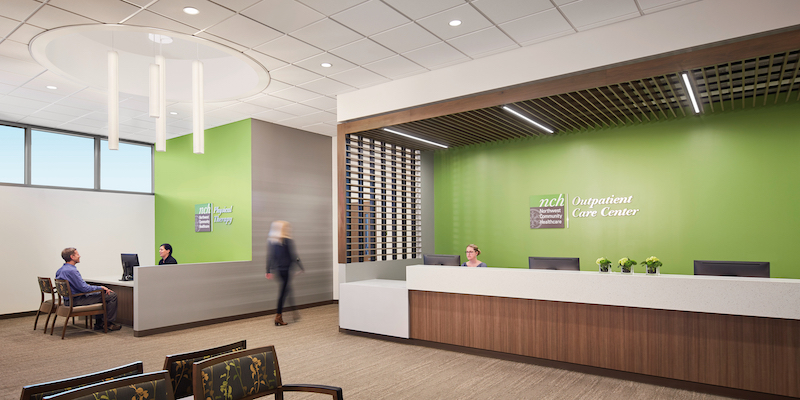
Northwest Community Healthcare agreed to finance the fitout and enlargement of a leased clinic (above) within the Foglia Foundation Health and Rec Center. And the Palatine Parks District contributed to keep the facility's pool open (below), which the district operates. Image: Dave Burk, courtesy of CannonDesign
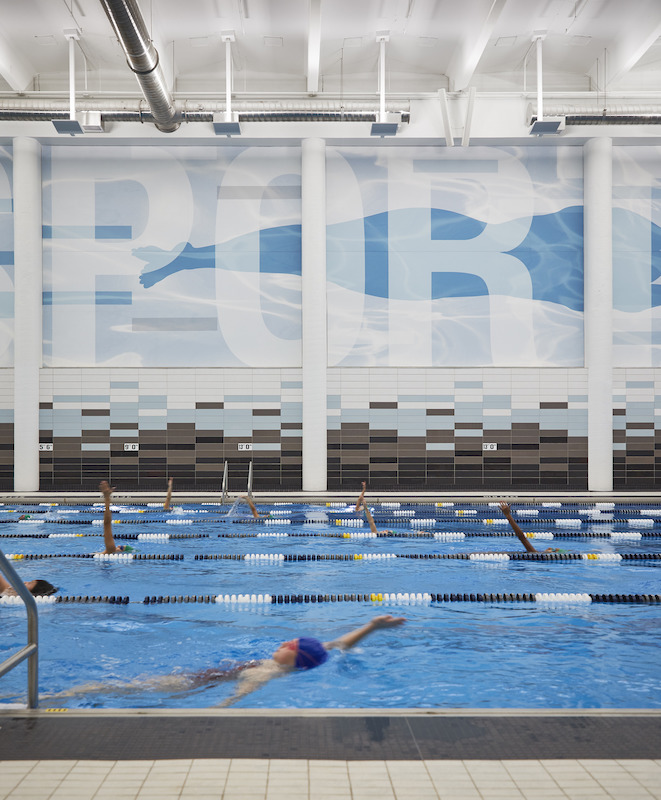
Palatine (Ill.) Park District kicked in $9 million toward the renovation to keep the facility’s pool open. The District operates the pool, says Paterson. whose programming includes aquatic, dance, sports, and fitness activities. “With one facility, we hit the trifecta,” says Mike Clark, the District’s executive director.
“I don’t know if we’ve ever done a project quite like this before,” says Roland Lemke, AIA, LEED AP, Design Principal for CannonDesign, about the way the renovation was funded. He observes that the rec center is mostly used by students during the day and by the community during nighttime hours.
CannonDesign was also involved in the new 120,000-sf Laurier YMCA Athletics and Recreation Centre in Brantford, Ont., which opened on September 14, 2018. The financing for this project came from the Y, the provincial and federal governments, corporate contributions, and Wilfrid Laurier University, whose campus is right next to the Y’s site.
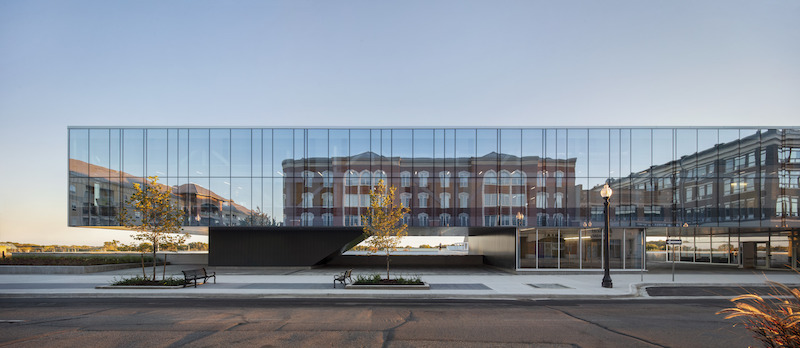
The Laurier Brantford (Ont.) YMCA and Recreational Center, whose nearly 68 million Canadian dollars in funding came from government, academic, and private sources. Image: Adrien Williams, courtesy of CannonDesign
This project had been in the works for at least eight years. Prior to the opening of the new building, the Y had been operating out of a small, temporary space, and the university had “a very small gym” for a student body that had grown to 2,500, say Antonio Araujo and Ulrike Gross, respectively the university’s Active VP-finance and administration and Acting VP-facilities and asset management.
The plans shifted into higher gear two years ago, thanks to 500,000 Canadian dollars in government grant money that paid for the building’s initial design, from which emerged “a rough concept,” says Araujo.
The project appealed to the city of Brantford as a way to help revitalize its downtown, says Genevieve Hladysh, senior regional manager for the Brantford-Hamilton-Burlington YMCA and Recreational Center. The new Y sits on a three-block site on the south side of the city, which tore down 39 mostly vacant retail buildings to clear space for construction. (Araujo and Gross note that the university initially wasn’t all that interested in this site whose main block was entirely below grade.)
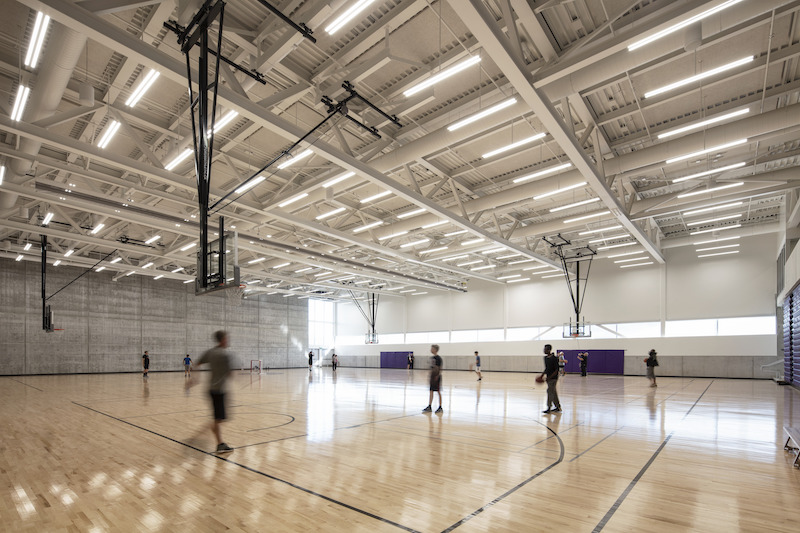
The Brantford YMCA includes a double gym. Image: Adrien Williams, courtesy of CannonDesign
The original budget for the new YMCA was 58.4 million Canadian dollars. But as more funding came on board, the budget rose to 67.7 million Canadian dollars. The federal and provincial governments each contributed C$16.7 million. The city provided $5.2 million, and another C$5.7 million was raised from a community capital campaign. The rest came from the YMCA and Laurier.
The building serves Brantford residents and university students with amenities that include an aquatics center, a double gym with retractable seating for 860 people, health consultation rooms, three studios, student lounge, and a 3,498-sf strength area.
This is the first Y to come together in an integrated space, and while the programming for each stakeholder group is spelled out contractually, “we tried to design the spaces to be as multifunctional as possible,” says Hladysh. Colleen McKenna, LEED AP, firmwide leader for CannonDesign’s sports, rec, and wellness practice, adds that while the university had a “big voice” in the programming, “there was balance and negotiation in the program distribution.”
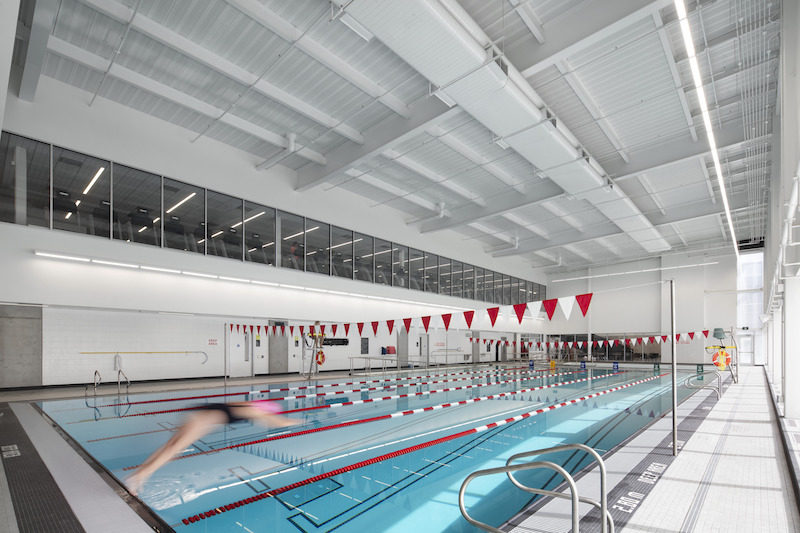
The Y's membership now exceeds 5,300, and its aquatics center is open to students and the community alike. Image: Adrien Williams, courtesy of CannonDesign
Part of the new Y’s increased cost was attributable to the construction unearthing a large archeological find: nearly 440,000 indigenous artifacts that included coins, clothing, and pottery, some of which might date back to 500 BCE. Hladysh says that the YMCA enlisted Six Nations partners to monitor the excavation. She adds that some kind of exhibit space within the new Y is under consideration.
Related Stories
| Jul 2, 2013
LEED v4 gets green light, will launch this fall
The U.S. Green Building Council membership has voted to adopt LEED v4, the next update to the world’s premier green building rating system.
| Jul 1, 2013
Report: Global construction market to reach $15 trillion by 2025
A new report released today forecasts the volume of construction output will grow by more than 70% to $15 trillion worldwide by 2025.
| Jun 28, 2013
Building owners cite BIM/VDC as 'most exciting trend' in facilities management, says Mortenson report
A recent survey of more than 60 building owners and facility management professionals by Mortenson Construction shows that BIM/VDC is top of mind among owner professionals.
| Jun 13, 2013
7 great places that represent excellence in environmental design
An adaptive reuse to create LEED Platinum offices, a park that honors veterans, and a grand national plaza are among the seven projects named winners of the 2013 Great Places Awards. The Environmental Design and Research Association recognize professional and scholarly excellence in environmental design, with special attention paid to the relationship between physical form and human activity or experience.
| Jun 5, 2013
USGBC: Free LEED certification for projects in new markets
In an effort to accelerate sustainable development around the world, the U.S. Green Building Council is offering free LEED certification to the first projects to certify in the 112 countries where LEED has yet to take root.
| Jun 3, 2013
Construction spending inches upward in April
The U.S. Census Bureau of the Department of Commerce announced today that construction spending during April 2013 was estimated at a seasonally adjusted annual rate of $860.8 billion, 0.4 percent above the revised March estimate of $857.7 billion.
| May 31, 2013
Japan to transform canal into world's largest outdoor pool
A wild proposal by the city of Osaka, Japan, would transform the Dotonbori Canal into a 2,625-foot-long, 40-foot-wide pool.
| May 21, 2013
RSMeans cost comparisons: pools, racquetball courts, bowling alleys, hockey/soccer facilities
Construction market analysts from RSMeans offer construction costs per square foot for four building types across 25 metro markets.
| May 20, 2013
Jones Lang LaSalle: All U.S. real estate sectors to post gains in 2013—even retail
With healthier job growth numbers and construction volumes at near-historic lows, real estate experts at Jones Lang LaSalle see a rosy year for U.S. commercial construction.
| May 17, 2013
First look: HKS' multipurpose stadium for Minnesota Vikings
The Minnesota Sports Facilities Authority (MSFA), the Minnesota Vikings and HKS Sports & Entertainment Group have unveiled the design of the State’s new multi? purpose stadium in Minneapolis, a major milestone in getting the $975 million stadium built on time and on budget.
















